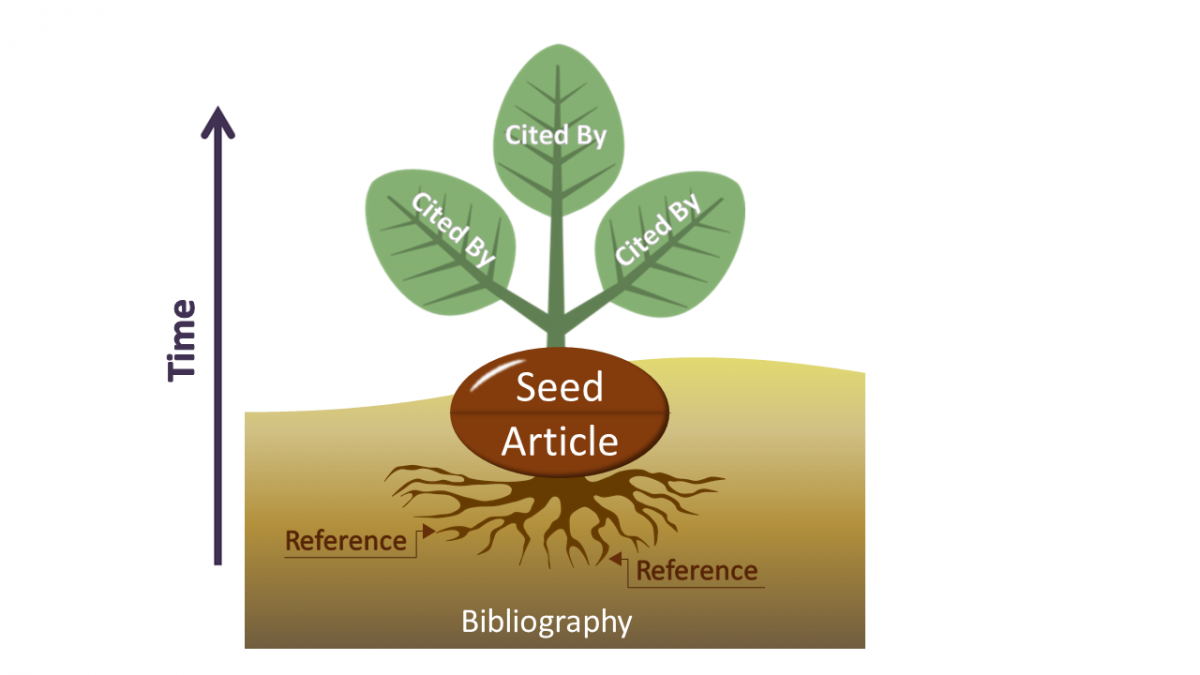Introduction
In this tutorial, you will explore how to broaden your search results through citation mining to quickly find additional sources related to your research topic. Citation mining is a research technique that utilizes the sources you've already found to discover more sources relevant to your topic.
Citation Mining
Citation mining is a great way to locate more sources on a topic, examine the impact of a source, and track the scholarly conversation surrounding a particular research idea. Imagine a source as a seed, its bibliography (list of references, works cited, etc.) as the roots, and any works that have cited your source as the sprout.

Once you've found your seed, you can employ the following citation mining methods.
Backward citation mining - Investigate roots by examining the sources within the bibliography of the seed article
Forward citation mining - Conduct a citation search to discover what works may have sprouted from the seed article
Related item mining - Compare bibliographies of similar seeds in the nearby soil to find similar works
Backward Citation Mining
With backward citation mining, you can look at the roots of the seed article: the works included in the reference list.
This can help you to:
- Find other sources to include in your research
- Explore how a topic has changed over time
- Discovery theories, constructs, and models used in research
- Identify experts, organizations, and/or institutions associated with the research topic
*Tip: While reading your research article, take notes on specific ideas, texts, and authors that relate to your research question. This will help you identify the most relevant sources within the articles bibliography or reference list.
Forward Mining
Backward citation mining is extremely useful for gathering more background knowledge about your topic; however, some sources found through this method may be older or outdated. Forward citation mining (also known as cited reference searching) helps you discover useful and relevant sources that cite your original article. This will help you find newer research that builds upon your seed article. To conduct forward citation mining you have to use a tool provided in some databases and search engines. This tool will return other sources that cite your seed article. A few examples of resources with forward citation mining tools are:
- PubMed
- Google Scholar
- Web of Science (*subscription based, UM does not subscribe)
It is important to note that citation mining tools have limitations and do not always return an exhaustive list of all resources that exist. If you are getting limited results in one tool, try using another one to mine your seed article! To see if a database you are using has a forward citation tool, look around for options that say cited references, cited by, or that use similar language.
Watch this video to see how you can use Google Scholar to conduct forward and related items citation mining.
"Forward Citation Mining with Google Scholar" by George Mason University Libraries is licensed under CC BY 4.0.
Related Item Mining
Related item mining is useful for broadening your perspective on a research topic. This technique can help you find related research, counter-arguments, and new information on your topic. There are many different ways to look for items related to your article, including:
- Search for other articles written by the same author(s)
- Look for other items in the same publication
- Use in the built-in "related articles" feature used in many databases and Google Scholar
Just like forward citation mining tools, related item mining tools can be found in multiple databases and can look and function differently from site to site. Look for language including related articles, browse similar content, etc. when exploringa database to find similar tools. It is important to learn and explore multiple resources to be exposed to a full breadth of results and optimize your search strategy.

 Adapted from Find Sources FAST! by The Teaching & Learning Team is licensed under a Creative Commons Attribution 4.0 International License.
Adapted from Find Sources FAST! by The Teaching & Learning Team is licensed under a Creative Commons Attribution 4.0 International License.